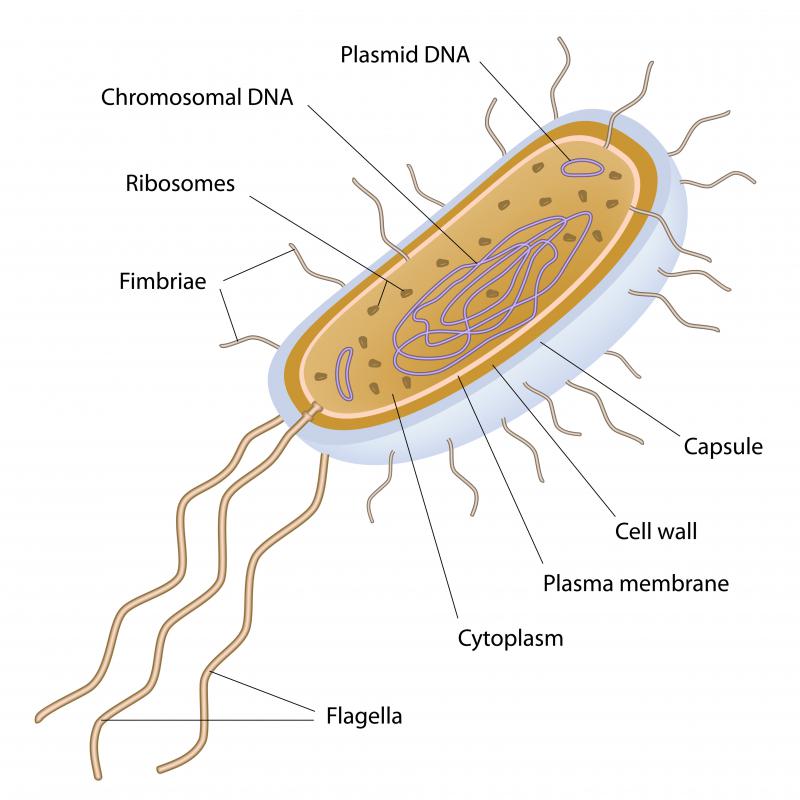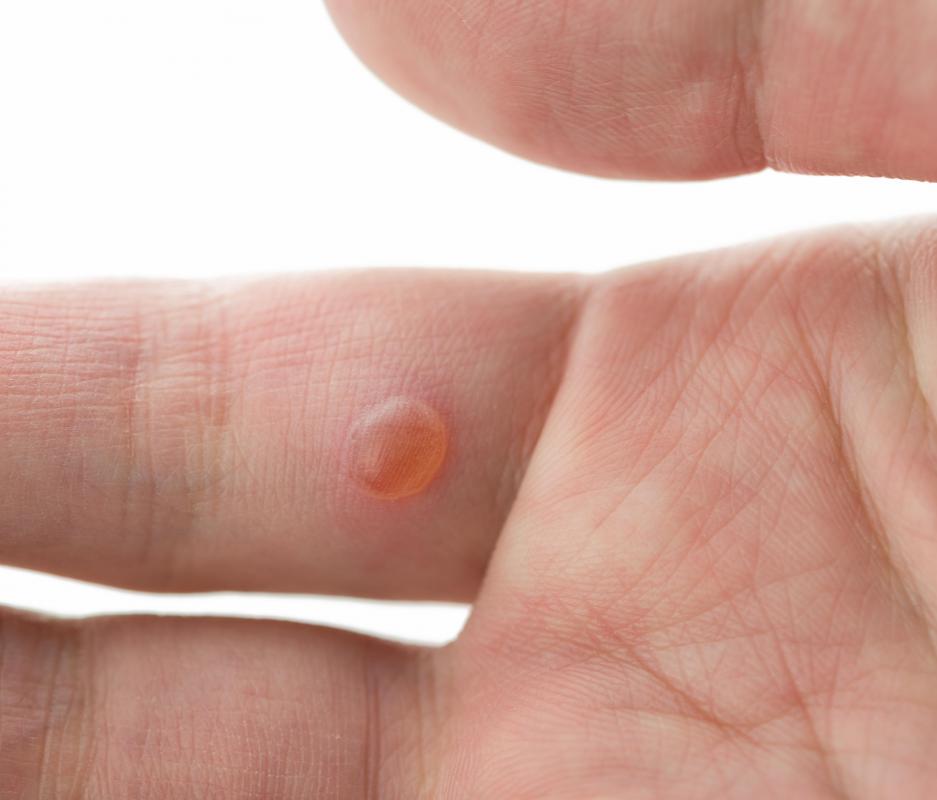At TheHealthBoard, we're committed to delivering accurate, trustworthy information. Our expert-authored content is rigorously fact-checked and sourced from credible authorities. Discover how we uphold the highest standards in providing you with reliable knowledge.
What is the Difference Between a Virus and Bacteria?
There are a number of differences between a virus and bacteria, or more appropriately, viruses and bacteria, including their relative sizes, reproduction methods, and resistance to medical intervention. Bacterium, the singular form of the word bacteria, is a one-celled living organism, with complete sets of both ribonucleic acid (RNA) and deoxyribonucleic acid (DNA) genetic codes. A virus is little more than a section of RNA or DNA covered by a protein shell. A bacterium, therefore, is at least a hundred times larger than a typical virus.
One major difference between viruses and bacteria is the method of reproduction. A bacterium is a completely self-contained and self-reproducing unit. When the time is right, a bacterium will split its DNA and RNA genetic material in two. Separate cell walls will build up around these two new bacteria, and this process will continue until thousands or millions of bacteria have formed. This is how strains of bacteria survive in almost every environment on Earth, including non-living surfaces like rocks or plastic.

A virus, on the other hand, cannot reproduce without a living host. A virus may lie dormant for thousands of years before finally coming into contact with a suitable host. Once it enters the body of a host, a virus uses leg-like appendages to clamp onto a cell and a spike or chemical coating to penetrate the cell wall.
Once inside a living cell, a virus replaces the cell's original DNA or RNA commands with its own genetic instructions. Those instructions are usually to make as many copies of the virus as possible. Once the individual cell has outlived its usefulness, it explodes and sends out thousands of copies of the original virus to other unsuspecting cells.

Ninety-nine percent of all known bacteria are considered beneficial to humans, or at least harmless. They spend their days breaking down organic matter and destroying harmful parasites. The small percentage of bacteria considered harmful to the human body, such as streptococcus and E. coli, are still performing the same functions as their less-toxic bacteria brethren.

Bacteria feed on the tissues of the human body and excrete toxins and acids. It is these toxins and irritating acids that cause many of the problems associated with bacterial infection. If the bacteria can be killed with antibiotics, the infections left behind should quickly clear up.
Most viruses, on the other hand, serve no beneficial purpose. Their sole mission in life is to create more viruses in order to assure survival of the strain. The deadly effect a virus has on its host is merely incidental.

When a virus enters the human body, it seeks out an acceptable host cell and seizes it without warning. Once the cell bursts, thousands of new viruses repeat the process on other healthy cells. By the time the body's natural defenses become aware of the invasion, the virus may have significant control over vital organs and tissues. Human Immunodeficiency Virus (HIV) and the Ebola virus are textbook examples of what dangerous viruses can do to a human body before they run their course.

Medical intervention and treatment is another major difference between viruses and bacteria. Bacteria are alive, which means they can be killed by some form of chemical agent. Antibiotics are chemical compounds that kill off bacteria by destroying their cell walls or neutralizing their ability to reproduce. The reason doctors prescribe lengthy rounds of antibiotics to patients is to create an environment in which bacteria cannot live. Although bacteria often eventually develop a tolerance for certain antibiotics, the effect is similar to using insecticide on insects.

Viruses, by comparison, are not considered living creatures. They cannot be "killed" in the same sense as antibiotics kill bacteria or insecticide kills insects. In fact, treatment of viral infections is often no treatment at all. The disease must run its course until the body can mount a successful defense on its own. Anti-viral treatments, when they exist, work on the principle of blocking the virus' own destructive methods. Either the RNA or DNA strand of the virus must be rendered harmless genetically, or the methods of breaking through a cell wall must be destroyed.
Anti-viral medications are not effective against all viruses, which is why certain diseases such as AIDS, HIV, and Ebola are still affecting millions of people world-wide. Scientists are still trying to understand the basic structure and genetic programming of viruses. Only by understanding how a virus works can a successful vaccine eventually be developed. Treating most bacteria-based diseases, on the other hand, can be a matter of finding the most effective antibiotic or using a broad spectrum approach.
AS FEATURED ON:
AS FEATURED ON:
















Discussion Comments
@anon337927: "Smarter beings." That sounds like something a virus would say.
Stop telling people to take all their pills as prescribed. We can read the bottle. Bacteria are big, whole organisms while a virus is a small piece of rna or dna (meaning they are simply a chain of atoms) not needing food or anything to remain structurally intact.
The question is: are viruses the engine which created or powered 'evolution' as we know it? They use a style of mix and match procreation, and are viruses exclusive to earth? These things could have been engineered by smarter beings long, long ago like tiny robots and sent out into space, and only now some have progressed to adapt to earth once reaching this planet, and quite possibly being the beginning of all life on this planet? Post 31 says uv-c radiation at the 254.7 nm frequency will 'destroy the genetic material of the organism.' I wonder if the protein shell might protect virus from this radiation or if this particular frequency of radiation is common or even exists in space?
Thanks for the great info. It helped me a lot in my science assignment.
Thanks. Basically being a non science teacher I was always confused. Thanks for the information provided by you. Neenadey
Great explanation. i am not a biological student, but i take this help for my profession.
Thanks for the great information!
Thanks for all information provided. One more comment is, can we use the nano silver solution to kill the virus effectively before it managed to find a host cell? Thanks
how can i really be for sure if all these facts are true? if i did an essay using some of the things you are saying, would you be 100 percent sure of your questions and remarks?
why is this true, and how do they know that all these facts they have are really just opinions?
Question #29: Your question asks how can viruses live for 1000 years, yet the HIV virus is difficult to transmit because it can't survive outside the body long?
Of course, some viruses are more resilient than others, yet most viruses are fragile outside their hosts. It depends on environmental conditions.
Consider for example: A piece of paper left outside will degrade in short order, after exposed to certain aspects of the environment it's in (rain, cold, heat, sun, etc.). Yet, the dead sea scrolls have remained intact (for the most part) for thousands of years because of the favorable environment they existed in during that time period. So it is for viruses.
OK, I should address a couple of questions given, but particularly #21. There is a process that can render both viruses and bacteria harmless -- actually a process which can kill molds, and many other micro-organisms completely as well. UV-C radiation. Ultra-violet light, at the 254.7nm frequency.
Exposure to UV-C light destroys the genetic material of the organism, rendering it completely harmless. Not particularly harmful to humans either. It is used primarily in hospitals, the food industry, and water purification systems and works great. Both viruses and bacteria are rather sensitive to heat, so hot tea works for that reason.
Viruses are non tissue discrimination, which means they can attack virtually any type cell of the body, while bacteria are relegated to moist, warm areas: throats, noses, lungs, bladders etc.
The article states that a virus can last maybe 1000's of years dormant, yet we're told that for example HIV is actually difficult to transmit (because it doesn't last long outside the body?).
Someone please explain!
this is a great article and explains in great detain the difference between bacteria and viruses - if you cannot understand after this article go back to kindergarten.
um no viruses are not bacteria. this article just explained that. sorry, but maybe a crash corse in reading is in order.
i still don't get the difference between viral and bacterial. maybe somebody can explain to me in simple words or an explanation that is easy to understand. all i know is they are all caused by bacteria.
i think the difference between viruses and bacteria is that viruses must have a living host cell to multiply whereas bacteria carry all their machinery needed for their growth and multiplication and that is what i have learned the difference is between viruses and bacteria.
Pre-1940 most mothers knew how to tell the difference between a viral or a bacterial infection. They also knew how to differently treat each one. Also how long to do that before it became important to go to the doctor. Simply teach that wisdom in schools. Many of today's unnecessary doctor visits would save millions.
In what temperature can a bacteria or a virus survive?
Given their differences, is it possible that a disinfectant-type product can kill both viruses and bacteria?
Viruses like HIV die faster when outside the body because they *need* living cells in order to reproduce.
Bacteria like other STDs live longer outside the body because they divide to reproduce and can live on plastic or other non-living things.
What physical appearance do you see between a virus and bacteria?
why do viruses like HIV last shorter outside the body than bacteria like gonorrhea, chlamydia or protozoa like trichomoniasis? like if infected semen containing any of these diseases exits the human body and enters the environment, HIV dies much quicker than any of the other organisms. the gonorrhea, chlamydia and trich will survive longer in the semen than the HIV in the semen. why?
You should take all the antibiotics a doc gives you because he/she has calculated with some accuracy how much it will take to kill -all- the pathogens they're trying to get. If you stop when you feel better you've only killed off say, the weakest 90%. This leaves only the strongest bacteria left, and with 90% of their competition for food and space out of the way, you've just bred a stronger infection.
I would like to echo what michaelp said and place an extra emphasis on consuming all prescribed antibiotics. Taking every pill in that bottle is very important because not only can the bacteria come back if all antibiotics are not consumed, but they can also come back *resistant* to antibiotics! If an individual infects another with this new resistant bacteria, a new strain is born that is now slightly more resilient. This presents quite an intellectual challenge for researchers as new bacteria is cropping up more resistant to our best medicine.
This is a non-professional opinion, but I believe the major reason why a physician insists a patient take the entire course of antibiotics is the reproductive nature of bacteria. One bacteria can become thousands or millions in a very short period of time, and antibiotics can only get ahead of the game if enough of them get into the fight against the invading bacteria.
If you stop taking the antibiotics before the end of the round, the remaining bacteria can reproduce and keep on infecting your body, thus keeping you sick. Only by allowing the antibiotics to overwhelm ALL of the living bacteria can you hope to get rid of the infection without it returning a few days later. As inconvenient as it may be, taking the entire round of antibiotics is the best way to go, even if you start feeling noticeably better during the middle of the round. Just because your infected ear pops or a swollen throat stops hurting doesn't mean you're cured.
Can somebody explain to me why it is important to complete the full round of antibiotics prescribed by the doctor?
It's not a second defense, as I know of it. But in some bacterial infections such as in syphilis, if a syphilitic patient gets a penicillin injection, the wall of the bacteria gets destroyed and the contents goes out to the body's environment resulting to a worsening of the patient's complaints. This reaction is called the Jarisch-Herxheimer reaction and is not considered as a drug allergy.
2nd defense? that's new to me too...
Bacteria are not classified as animals because they are unicellular prokaryotes; all animals are multicellular eukaryotes.
I am not aware of this bacterial secondary mode of attack either. Bacterial wall is relatively tough, but also resilient and it gives bacteria it's shape. It also protects it from the environment. Some bacteria have rather strong walls, while others do not. Bacteria reproduce by fission, one cell breaks into two. The process takes anywhere from a few minutes to a few hours, depending on condition and type of bacteria
I never knew that there was a second defense for bacteria.
I was told that bacteria has a second defense. If you just break a bacteria, the protein shell can also cause health problems. This second mode of attack has a name which I can not remember. Has anyone else heard of this?
Post your comments